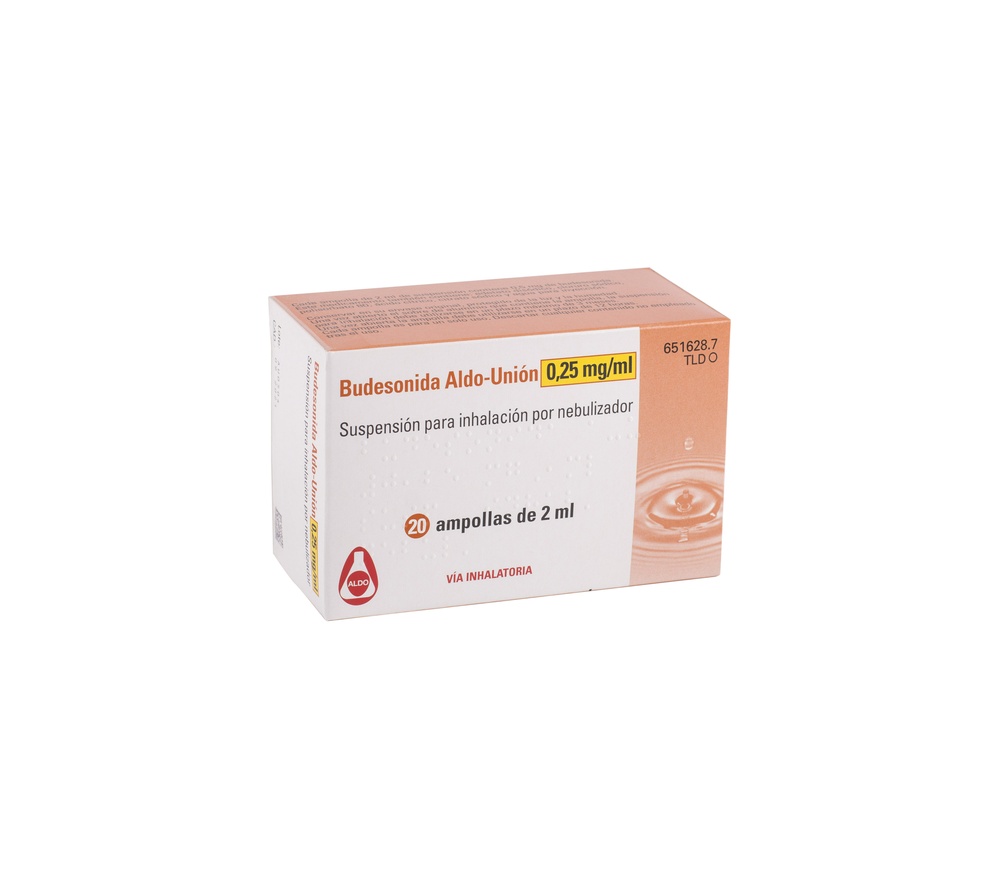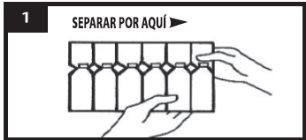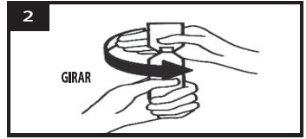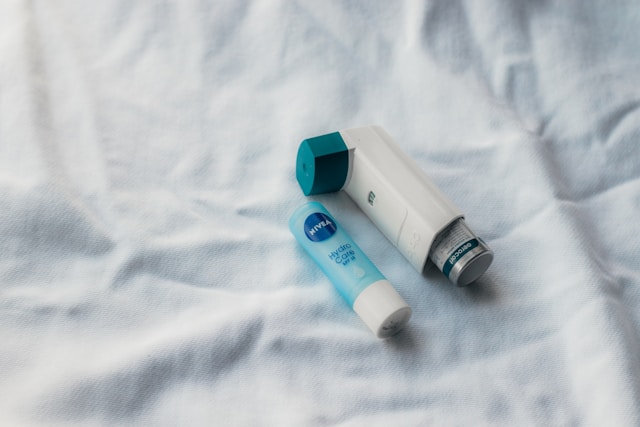

BUDESONIDE ALDO-UNION 0.25 mg/ml SUSPENSION FOR NEBULIZER INHALATION

Ask a doctor about a prescription for BUDESONIDE ALDO-UNION 0.25 mg/ml SUSPENSION FOR NEBULIZER INHALATION

How to use BUDESONIDE ALDO-UNION 0.25 mg/ml SUSPENSION FOR NEBULIZER INHALATION
Introduction
Package Leaflet: Information for the User
Budesonide Aldo-Union 0.25 mg/ml Suspension for Nebuliser Inhalation
Budesonide
Read all of this leaflet carefully before you start taking this medicine because it contains important information for you.
- Keep this leaflet, you may need to read it again.
- If you have any further questions, ask your doctor or pharmacist.
- This medicine has been prescribed for you only. Do not pass it on to others. It may harm them, even if their signs of illness are the same as yours.
- If you experience any side effects, talk to your doctor or pharmacist. This includes any possible side effects not listed in this leaflet. See section 4.
Contents of the pack:
- What Budesonide Aldo-Union is and what it is used for.
- What you need to know before you use Budesonide Aldo-Union.
- How to use Budesonide Aldo-Union.
- Possible side effects.
- Storage of Budesonide Aldo-Union.
- Contents of the pack and other information
1. What Budesonide Aldo-Union is and what it is used for
Budesonide belongs to a group of steroid compounds called glucocorticoids that are used to reduce or prevent inflammatory reactions (inflammation) in the lungs.
This medicine is used for the treatment of asthma. It is used in patients in whom other types of inhalers, such as pressurized inhalers or inhalers containing a powder formulation, have not produced satisfactory results or are not suitable.
This medicine may also be used in hospitals for the treatment of very severe cases of pseudocroup (a throat disease that can cause difficulty breathing).
2. What you need to know before you use Budesonide Aldo-Union
Do not use Budesonide Aldo-Union:
If you are allergic to budesonide or any of the other components of this medicine (listed in section 6).
Warnings and precautions
Talk to your doctor or pharmacist before starting to take Budesonide Aldo-Union if any of the following situations apply to you:
- If you have or have had tuberculosis
- If you have or have had liver disease or problems.
- If you have a fungal, viral, or other infection of the airways, e.g., a cold or lung infection.
Contact your doctor if you experience blurred vision or other visual disturbances.
If you are going to switch from treatment with oral corticosteroids (such as prednisolone) to Budesonide for nebuliser inhalation, you may feel unwell during the change. You may also experience symptoms that were suppressed by the oral corticosteroids, such as allergic rhinitis (itching, nasal congestion, or runny nose), eczema (dry skin, itching), muscle and joint pain. You should inform your doctor if this happens.
Budesonide, suspension for nebuliser inhalation is not suitable for use in acute attacks of shortness of breath. A sudden attack of dyspnoea (difficulty breathing) should be treated with a short-acting bronchodilator.
If you experience more wheezing and/or difficulty breathing immediately after using Budesonide, suspension for nebuliser inhalation, stop using Budesonide, suspension for nebuliser inhalation immediately and consult your doctor.
To reduce the risk of oral candidiasis (white patches on the tongue or in the mouth), rinse your mouth with water (spit out the water, do not swallow it) and brush your teeth after using Budesonide, suspension for nebuliser inhalation. Inform your doctor if you develop oral candidiasis.
Children and adolescents
On rare occasions, long-term treatment with budesonide may delay normal growth in children and adolescents. If your child uses this medicine for a prolonged period, it is normal for your doctor to want to check their height periodically.
Budesonide is a steroid. You should be aware that, as a result of using this medicine, you may test positive in doping tests. If this concerns you, you should consult your doctor.
Using Budesonide Aldo-Union with other medicines:
Tell your doctor if you are taking any of the following medicines that may interact with this product:
- Medicines for the treatment of fungal infections, such as ketoconazole or itraconazole
- Medicines for the treatment of HIV called ritonavir or saquinavir
- The antibiotics erythromycin and clarithromycin
- Other medicines to help you breathe.
- Estrogens and steroid contraceptives.
Tell your doctor or pharmacist if you are using, have recently used, or might use any other medicine.
Pregnancy and breastfeeding
If you are pregnant or breastfeeding, think you may be pregnant, or plan to become pregnant, consult your doctor or pharmacist before taking this medicine. If you become pregnant while using this medicine, you should contact your doctor as soon as possible.
Driving and using machines
The influence of inhaled budesonide on the ability to drive and use machines is negligible.
3. How to use Budesonide Aldo-Union
Follow the instructions for administration of the medicine indicated by your doctor. In case of doubt, consult your doctor again.
Your doctor will indicate the correct dose depending on the severity of your asthma.
Asthma
You may notice that your asthma improves after 3 days, but it will take 2 to 4 weeks to achieve the full effect. It is essential that you continue taking the medicine as prescribed by your doctor, even if you already feel better.
Adults (including the elderly) and adolescents 12 years and older:
The usual dose is 0.5 to 2 mg of budesonide per day. This dose will usually be divided into two doses, although if your asthma is stable and not severe, your doctor may advise you to take it once a day. Your doctor will advise you on how and when to take the medication, and you should always follow their instructions.
Children from 6 months to 11 years:
The usual dose is 0.25 to 1.0 mg of budesonide per day. Your doctor will advise you when your child should use the medicine, but it will usually be in two doses per day. However, if your child's asthma is stable and not severe, your doctor may advise you to give the medicine once a day.
Pseudocroup:
The normal dose in infants and children with pseudocroup is 2 mg. It can be administered in a single dose or in two doses of 1 mg, separated by a 30-minute interval. The administration can be repeated every 12 hours until improvement is observed, for a maximum of 36 hours.
Method of use
The medicine must be used with a nebuliser. The mist produced is inhaled through a mouthpiece or mask. Ultrasonic nebulisers must not be used with this medicine.
To take the medicine, follow these steps:
|
|
| |
| |
|
- Gently shake the reservoir again and start the nebulisation. During nebulisation, breathe in the mist of the nebulised suspension deeply and slowly.
- When no more mist comes out of the mouthpiece or mask, the treatment is finished.
- When you have finished, rinse your mouth with water (do not swallow the water) and brush your teeth. If you have used a mask, wash your face well. It is essential to do this to reduce the risk of some side effects associated with this medicine.
- After each use, wash the nebuliser thoroughly. Wash the nebuliser reservoir and mouthpiece or mask with warm water using a mild detergent, following the manufacturer's instructions. The nebuliser should be rinsed well and dried by connecting the reservoir to the compressor or air outlet.
It is essential that you always follow the manufacturer's instructions that come with the nebuliser. If you are unsure about how to use the nebuliser, consult your doctor or pharmacist.
Your doctor may also prescribe the following:
- Your doctor may consider adding oral steroids to your treatment during critical periods (such as if you have an infection), before an operation, or if you have been taking a high dose of an inhaled steroid for a prolonged period.
- If you have been taking oral steroids for your asthma, your doctor will reduce the amount you need to take once you start using Budesonide suspension for nebuliser inhalation. Due to this, you may notice some symptoms such as a stuffy nose or runny nose, lack of energy, depression, eczema, and muscle or joint pain. If any of these symptoms persist and are very bothersome, you should consult your doctor.
- Your doctor may advise you to mix this medicine with other suspensions that contain other active substances that act on the respiratory system, such as salbutamol, terbutaline, sodium cromoglycate, and ipratropium bromide. If so, follow their instructions carefully. Do not mix this medicine unless your doctor has specifically instructed you to do so.
If you have used more Budesonide Aldo-Unionthan you should
Contact your doctor or pharmacist as soon as possible. Remember to take the package and any remaining ampoules with you. It is essential that you take the dose indicated on the label by the pharmacist or the dose recommended by your doctor. You should not increase or decrease the dose without medical consent.
In case of overdose or accidental ingestion, consult your doctor, pharmacist, or call the Toxicology Information Service immediately. Telephone: 91 562 04 20, indicating the medicine and the amount taken.
If you forget to use Budesonide Aldo-Union
Do not take a double dose to make up for forgotten doses. Simply take the next dose at the right time.
If you have any doubts about the use of this medicine, ask your doctor or pharmacist.
4. Possible side effects
Like all medicines, this medicine can cause side effects, although not everybody gets them.
All medicines can cause allergic reactions, although serious allergic reactions are very rare. Tell your doctor immediately if you suddenly experience wheezing, difficulty breathing, swelling of the eyelids, face, or lips, rash, or itching (especially if it affects the whole body).
Rarely, inhaled medicines like budesonide can cause acute wheezing and/or difficulty breathing. If this happens, stop using the medicine immediately and consult your doctor.
The following side effects have been reported:
Common: may affect up to 1 in 10 people:Muscle pain and/or irritation of the mouth (including oral thrush or ulcers in the mouth), hoarseness, throat irritation, difficulty swallowing, and cough.
Uncommon: may affect less than 1 in 100 people
Cataracts (opacity of the eye lens), depression or feeling anxious, muscle spasms, tremors, blurred vision.
Rare: may affect up to 1 in 1,000 people:Skin reactions*, including itching, rash, bruising, inflammation, redness, and/or skin eruptions, swelling, growth delay in children and adolescents, hypersensitivity* (an allergy to the medicine), and bronchospasm (contraction of the airway muscles that causes wheezing). Voice problems.
Suppression of the adrenal gland (a small gland near the kidney) may occur. The main symptoms of adrenal suppression include headache, fatigue, nausea, and vomiting, weight loss, stomach pain, and loss of appetite.
Feeling restless, nervous, overexcited, or irritable (these effects are more likely to occur in children)
Very rare: may affect up to 1 in 10,000 people: Decreased bone mineral density (thinning of the bone).
Frequency not known: cannot be estimated from the available data
Glaucoma (increased pressure inside the eye), aggression, increased motor activity (difficulty staying still), sleep disorders.
Reporting of side effects
If you experience any side effects, talk to your doctor or pharmacist. This includes any possible side effects not listed in this leaflet. You can also report side effects directly through the Spanish Pharmacovigilance System for Human Use Medicines: www.notificaRAM.es. By reporting side effects, you can help provide more information on the safety of this medicine.
5. Storage of Budesonide Aldo-Union
Keep this medicine out of the sight and reach of children.
Do not use this medicine after the expiry date stated on the carton or pouch after EXP. The expiry date is the last day of the month stated.
Store the ampoules in their aluminium pouch and in the original package to protect them from light and moisture.
Once an ampoule is opened, it must be used within 12 hours. After this time, any unused amount must be discarded.
Once a pouch is opened, the ampoules can be stored for up to 3 months (it is recommended to note the opening date on the pouch to help you remember it)
Medicines should not be disposed of via wastewater or household waste. Place the packaging and any unused medicine in the SIGRE collection point at your usual pharmacy or any other medicine waste collection system. If in doubt, ask your pharmacist how to dispose of the packaging and any unused medicine. This will help protect the environment.
6. Contents of the pack and other information
Composition of Budesonide Aldo-Union
- The active substance is Budesonide
- The other components are disodium edetate, sodium chloride, polysorbate 80, citric acid, sodium citrate, and purified water.
Budesonide Aldo-Union 0.25 mg/ml, suspension for nebuliser inhalation contains 0.5 mg of budesonide (0.25 mg/ml) as the active substance in each 2 ml ampoule.
Appearance of Budesonide Aldo-Unionand pack contents
Budesonide Aldo-Union is presented in plastic ampoules with 2 ml of white or off-white suspension to be nebulised (converted into a fine mist for inhalation).
The ampoules are packaged in strips of 4, 5, 8, 10, or 12 ampoules in an aluminium pouch, which is then packaged in a cardboard box. There are packs containing 5, 20, 24, 40 (2 x 20), or 60 ampoules. Not all pack sizes may be marketed.
Marketing Authorisation Holder:
Laboratorio Aldo-Unión, S.L. c/ Baronesa de Malda nº 73, Esplugues de Llobregat, 08950 Barcelona (Spain)
Manufacturer:
UNITHER PHARMACEUTICALS 151 Rue Andre Durouchez, Espace Industriel Nord Amiens Cedex 2. 80084 France
This medicine is authorised in the Member States of the EEA under the following names:
Denmark Budesonid Arrow
Belgium Budesonide Sandoz 0.25mg/ml vernevelsuspensie
Germany BUDENOBRONCH 0.5mg/2 ml Suspension für einen Vernebler
Spain Budesonida Aldo-Unión 0.25mg/ml suspensión para inhalación por nebulizador
Italy Budesonide Sandoz 0.25 mg/ml sospensione per nebulizzatore
Netherlands Budesonide Sandoz 0.25mg/ml vernevelsuspensie in ampul, 2ml.
Norway Budesonid Arrow inhalasjonsvæske til nebulisator, suspensjon 0.25mg/ml
Sweden Budesonid Arrow 0.25mg/ml Suspension för nebulisator
United Kingdom Budesonide 0.5mg Nebuliser Suspension
Date of last revision of this leaflet:May 2017
Detailed and updated information on this medicine is available on the website of the Spanish Agency for Medicines and Health Products (AEMPS) http://www.aemps.gob.es/

How much does BUDESONIDE ALDO-UNION 0.25 mg/ml SUSPENSION FOR NEBULIZER INHALATION cost in Spain ( 2025)?
The average price of BUDESONIDE ALDO-UNION 0.25 mg/ml SUSPENSION FOR NEBULIZER INHALATION in December, 2025 is around 6.15 EUR. Prices may vary depending on the region, pharmacy, and whether a prescription is required. Always check with a local pharmacy or online source for the most accurate information.
- Country of registration
- Average pharmacy price6.15 EUR
- Active substance
- Prescription requiredYes
- Manufacturer
- This information is for reference only and does not constitute medical advice. Always consult a licensed doctor before taking any medication. Oladoctor is not responsible for medical decisions based on this content.
- Alternatives to BUDESONIDE ALDO-UNION 0.25 mg/ml SUSPENSION FOR NEBULIZER INHALATIONDosage form: PULMONARY INHALATION, 0.25 mg/mlActive substance: budesonideManufacturer: Laboratorio Aldo Union S.L.Prescription requiredDosage form: PULMONARY INHALATION, 0.5 mg/mlActive substance: budesonideManufacturer: Laboratorio Aldo Union S.L.Prescription requiredDosage form: PULMONARY INHALATION, 0.04000 gActive substance: budesonideManufacturer: Laboratorio Aldo Union S.L.Prescription required
Alternatives to BUDESONIDE ALDO-UNION 0.25 mg/ml SUSPENSION FOR NEBULIZER INHALATION in other countries
The best alternatives with the same active ingredient and therapeutic effect.
Alternative to BUDESONIDE ALDO-UNION 0.25 mg/ml SUSPENSION FOR NEBULIZER INHALATION in Poland
Alternative to BUDESONIDE ALDO-UNION 0.25 mg/ml SUSPENSION FOR NEBULIZER INHALATION in Ukraine
Online doctors for BUDESONIDE ALDO-UNION 0.25 mg/ml SUSPENSION FOR NEBULIZER INHALATION
Discuss dosage, side effects, interactions, contraindications, and prescription renewal for BUDESONIDE ALDO-UNION 0.25 mg/ml SUSPENSION FOR NEBULIZER INHALATION – subject to medical assessment and local rules.

















